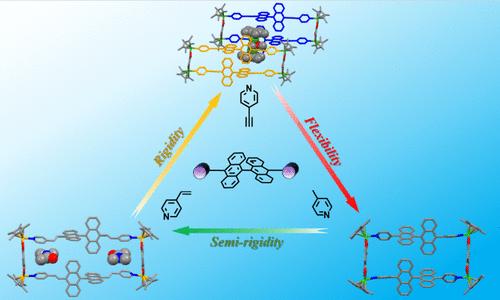通过配体调控实现客体自适应选择的超分子主客体系统
IF 4.7
2区 化学
Q1 CHEMISTRY, INORGANIC & NUCLEAR
引用次数: 0
摘要
在主客体化学中,保持原有的超分子拓扑结构,同时实现对各种客体分子的选择性识别和封装仍然是一个关键的挑战。在本研究中,我们成功地设计并合成了一系列由9,9 ' -二蒽衍生的双功能吡啶配体,然后将其与半夹心的Cp*Ir/Rh构建块偶联,形成四核超分子金属环。通过精确调整配体的尺寸和构建块的共轭区域,我们有效地指导了这些超分子结构中的主客体系统。我们进一步探讨了影响客体分子筛选的空间构象因素。三种双齿吡啶配体的独特性质显著影响了分子内/分子间的π -π堆积、CH-π相互作用和氢键,从而影响了体系对不同客体分子的识别和耐受能力。自分类研究表明,在没有外部客体分子干扰的情况下,某些配体和构建块在大环形成过程中具有选择性偏好。这些研究还证明了连接大环的显著拓扑稳定性,确保了高强度的构象完整性。利用单晶x射线衍射、核磁共振(NMR)和质谱技术对这些超分子金属环的结构和行为进行了确证。本文章由计算机程序翻译,如有差异,请以英文原文为准。

Supramolecular Host–Guest System That Realizes Adaptive Selection of the Guest through Ligand Regulation
In host–guest chemistry, preserving the original supramolecular topology while achieving the selective recognition and encapsulation of various guest molecules remains a key challenge. In this study, we successfully designed and synthesized a series of bifunctional pyridine ligands derived from 9,9′-bianthracene, which were then coupled with half-sandwiched Cp*Ir/Rh building blocks to form tetranuclear supramolecular metallacycles. Through precise tuning of the ligands’ dimensions and the conjugation areas of the building blocks, we effectively directed the host–guest system within these supramolecular structures. We further explored the spatial conformational factors influencing guest molecule screening. The unique properties of the three bidentate pyridyl ligands significantly affected the intra/intermolecular π–π stacking, CH-π interactions, and hydrogen bonding, which in turn influenced the system’s ability to recognize and tolerate different guest molecules. Self-sorting investigations revealed a selective preference for certain ligands and building blocks during macrocyclic formation with no interference from externally imposed guest molecules. These studies also demonstrated the remarkable topological stability of the ligated macrocycles, ensuring high-intensity conformational integrity. The specific structures and behaviors of these supramolecular metallacycles were confirmed by using single-crystal X-ray diffraction, nuclear magnetic resonance (NMR), and mass spectrometry techniques.
求助全文
通过发布文献求助,成功后即可免费获取论文全文。
去求助
来源期刊

Inorganic Chemistry
化学-无机化学与核化学
CiteScore
7.60
自引率
13.00%
发文量
1960
审稿时长
1.9 months
期刊介绍:
Inorganic Chemistry publishes fundamental studies in all phases of inorganic chemistry. Coverage includes experimental and theoretical reports on quantitative studies of structure and thermodynamics, kinetics, mechanisms of inorganic reactions, bioinorganic chemistry, and relevant aspects of organometallic chemistry, solid-state phenomena, and chemical bonding theory. Emphasis is placed on the synthesis, structure, thermodynamics, reactivity, spectroscopy, and bonding properties of significant new and known compounds.
 求助内容:
求助内容: 应助结果提醒方式:
应助结果提醒方式:


